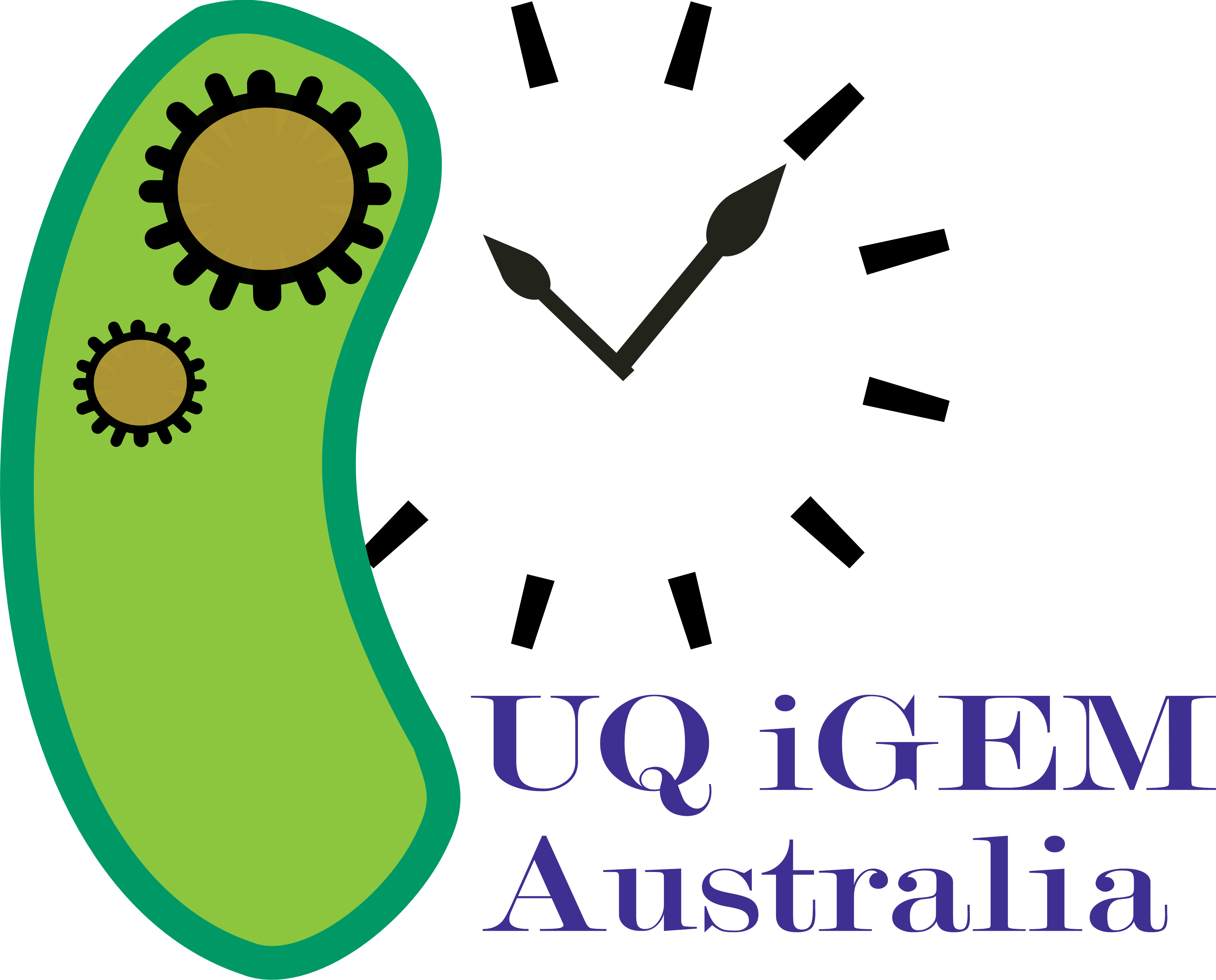Team:UQ-Australia/Parts
From 2011.igem.org
(→Parts) |
|||
| (22 intermediate revisions not shown) | |||
| Line 1: | Line 1: | ||
{{:Team:UQ-Australia/Template:Header}} | {{:Team:UQ-Australia/Template:Header}} | ||
{|style="width:100%;" border="0" cellpadding="10" cellspacing="0" | {|style="width:100%;" border="0" cellpadding="10" cellspacing="0" | ||
| + | |- valign="top" | ||
|rowspan="2"|The human circadian rhythm drives many important processes in the body in accordance with the sleep/wake cycle. A characteristic of this biological clock is the periodic oscillation of gene expression. Current parts in the Registry designed to regulate periodic oscillations of gene expression have shown limited success. | |rowspan="2"|The human circadian rhythm drives many important processes in the body in accordance with the sleep/wake cycle. A characteristic of this biological clock is the periodic oscillation of gene expression. Current parts in the Registry designed to regulate periodic oscillations of gene expression have shown limited success. | ||
Here we demonstrate a biological clock being standardised as a set of BioBrick parts. | Here we demonstrate a biological clock being standardised as a set of BioBrick parts. | ||
Our network is controlled by an engineered promoter, Plac/ara, which features both an activator and a repressor domain. This controls the production of downstream genes to activate other inducible promoters, pBAD and GlnAp2, eventually leading to the production of a repressor protein, lacI, which inhibits Plac/ara, resulting in oscillatory expression. This project shows the feasibility of standardising the biological clock in E. coli and grounds further development for applications in regulated drug/hormone delivery and ion channel control. | Our network is controlled by an engineered promoter, Plac/ara, which features both an activator and a repressor domain. This controls the production of downstream genes to activate other inducible promoters, pBAD and GlnAp2, eventually leading to the production of a repressor protein, lacI, which inhibits Plac/ara, resulting in oscillatory expression. This project shows the feasibility of standardising the biological clock in E. coli and grounds further development for applications in regulated drug/hormone delivery and ion channel control. | ||
| - | ! | + | |
| + | We were not completely successful in our experimental endeavours towards making the BioBrick parts to be submitted to the registry, however we were able to add BioBrick sites to each part listed below. Therefore, except for Plac/ara we had all the parts ready to be cloned into the iGEM submission vector pSB1C3. For more information on the laboratory work please see the [https://2011.igem.org/Team:UQ-Australia/Project '''Project page''']. | ||
| + | ! [[File:UQ-Australia_logo_2011.png|125x125px|link=https://2011.igem.org/Team:UQ-Australia]] | ||
|- | |- | ||
| - | | | + | | |
|} | |} | ||
| - | |||
| - | |||
| - | |||
| - | |||
===<span style="color:#558822"> Parts </span>=== | ===<span style="color:#558822"> Parts </span>=== | ||
| Line 18: | Line 17: | ||
| - | + | {| border="0" cellpadding="10" cellspacing="0" width="892" | |
| - | {| border=" | + | |width="100"|[[File:MultiplePromoter image.png|100x100px|link=https://2011.igem.org/File:Promoter_image.png#filelinks]] |
| - | |width="100"|[[File:MultiplePromoter image.png|link=https://2011.igem.org/File:Promoter_image.png#filelinks]] | + | |
|width="250"|'''<span style="color:#D4A017">Plac/ara</span>''' | |width="250"|'''<span style="color:#D4A017">Plac/ara</span>''' | ||
| Line 27: | Line 25: | ||
|width="250"|'''<span style="color:#D4A017">glnG</span>''' | |width="250"|'''<span style="color:#D4A017">glnG</span>''' | ||
Encodes for DNA-binding protein(NR1), the activity of which depends on its phosphorylation. Drives expression of genes under GlnAp2 promoter | Encodes for DNA-binding protein(NR1), the activity of which depends on its phosphorylation. Drives expression of genes under GlnAp2 promoter | ||
| - | |||
| - | |||
|- | |- | ||
|[[File:Gene image.png|100x100px]] | |[[File:Gene image.png|100x100px]] | ||
|'''<span style="color:#D4A017">araC</span>''' | |'''<span style="color:#D4A017">araC</span>''' | ||
Encodes for a positive regulatory protein for L-arabinose utilization in E.coli | Encodes for a positive regulatory protein for L-arabinose utilization in E.coli | ||
| - | |[[File:PositivePromoter.png]] | + | |[[File:PositivePromoter.png|100x100px]] |
|'''<span style="color:#D4A017">pBAD</span>''' | |'''<span style="color:#D4A017">pBAD</span>''' | ||
L-arabinose inducible promoter | L-arabinose inducible promoter | ||
| - | |||
| - | |||
|- | |- | ||
|[[File:Gene image.png|100x100px]] | |[[File:Gene image.png|100x100px]] | ||
|'''<span style="color:#D4A017">LacI</span>''' | |'''<span style="color:#D4A017">LacI</span>''' | ||
DNA-binding transcriptional inhibitor for lac-operon | DNA-binding transcriptional inhibitor for lac-operon | ||
| - | |[[File:PositivePromoter.png| | + | |[[File:PositivePromoter.png|100x100px]] |
|'''<span style="color:#D4A017">GlnAp2</span>''' | |'''<span style="color:#D4A017">GlnAp2</span>''' | ||
Promoter driven by phosphorylated GlnG(NR1) | Promoter driven by phosphorylated GlnG(NR1) | ||
| - | |||
| - | |||
|} | |} | ||
Latest revision as of 03:58, 6 October 2011
 "
"





